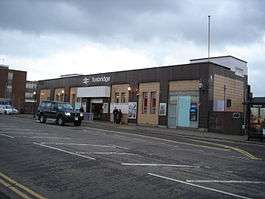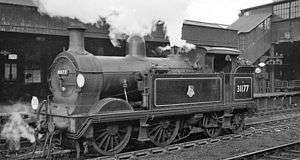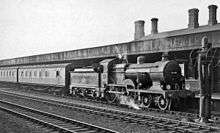Tonbridge railway station
| Tonbridge | |
|---|---|
 | |
| Location | |
| Place | Tonbridge |
| Local authority | Borough of Tonbridge and Malling |
| Coordinates | 51°11′28″N 0°16′16″E / 51.191°N 0.271°ECoordinates: 51°11′28″N 0°16′16″E / 51.191°N 0.271°E |
| Grid reference | TQ586460 |
| Operations | |
| Station code | TON |
| Managed by | Southeastern |
| Number of platforms | 4 |
| DfT category | B |
|
Live arrivals/departures, station information and onward connections from National Rail Enquiries | |
| Annual rail passenger usage* | |
| 2004/05 | 3.810 million |
| 2005/06 |
|
| 2006/07 |
|
| 2007/08 |
|
| 2008/09 |
|
| 2009/10 |
|
| 2010/11 |
|
| 2011/12 |
|
| – Interchange | 0.515 million |
| 2012/13 |
|
| – Interchange |
|
| 2013/14 |
|
| – Interchange |
|
| 2014/15 |
|
| – Interchange |
|
| History | |
| 26 May 1842 | Opened as "Tunbridge" |
| January 1852 | Renamed (Tunbridge Junction) |
| 1864 | Resited 310 yards (280 m) west |
| May 1893 | Renamed (Tonbridge Junction) |
| July 1929 | Renamed (Tonbridge)[1] |
| National Rail – UK railway stations | |
| * Annual estimated passenger usage based on sales of tickets in stated financial year(s) which end or originate at Tonbridge from Office of Rail and Road statistics. Methodology may vary year on year. | |
|
| |
| Development of | |||||||||||||||||||||||||||||||||||||||||||||||||||||||||
|---|---|---|---|---|---|---|---|---|---|---|---|---|---|---|---|---|---|---|---|---|---|---|---|---|---|---|---|---|---|---|---|---|---|---|---|---|---|---|---|---|---|---|---|---|---|---|---|---|---|---|---|---|---|---|---|---|---|
| |||||||||||||||||||||||||||||||||||||||||||||||||||||||||
| |||||||||||||||||||||||||||||||||||||||||||||||||||||||||
| |||||||||||||||||||||||||||||||||||||||||||||||||||||||||
| |||||||||||||||||||||||||||||||||||||||||||||||||||||||||
| |||||||||||||||||||||||||||||||||||||||||||||||||||||||||
| |||||||||||||||||||||||||||||||||||||||||||||||||||||||||


Tonbridge railway station is a station serving the town of Tonbridge in Kent, England. It is a junction between two important commuter routes; the South Eastern Main Line serving Ashford, Ramsgate and Dover and the Hastings Main Line serving Tunbridge Wells and Hastings, as well as a branch to Redhill. The station is operated by Southeastern, and is serviced by trains operated by Southeastern and Southern. There are four platforms; however, platform 4 is only used occasionally in peak times.
History
The South Eastern Railway (SER) first reached Tonbridge (then known as Tunbridge) in May 1842.[2] The site of the original station was on the east side of the road bridge over the railway, opposite its current location to the west of the bridge.[3] The building of the station obliterated the last remains of Tonbridge Priory.[4] At the time, the line ran to London Bridge via Croydon and Redhill using the Brighton Main Line. It served as a temporary terminus until December 1842, when the line reached Ashford. A couple of years later the through line to Dover opened. A small engine shed was built; the date of opening is uncertain but it is presumed to date from the opening of the line. On 20 September 1845, a branch to Tunbridge Wells opened and the station was renamed Tunbridge Junction. Over the next five years the branch was extended to Hastings. Access to the line to Hastings was via an indirect link which required a reverse. This arrangement lasted until 1857 when a steeply climbing direct route was opened.[2]
However, being forced to share tracks with its rival, the London, Brighton and South Coast Railway, as well as competition from the London, Chatham and Dover Railway meant that the SER decided to build a new route from London Bridge, which ran via Chislehurst and Orpington. The cut-off joined the main line at Tonbridge.[5] This prompted a rebuild of the station, and in 1864 it was rebuilt on its current site with four platforms. The original station was demolished in 1865[6] after closure but the entrance gateways are still in situ. The down side entrance is in Vale Road opposite Sainsbury's, and the up side entrance is in Priory Road forming the entrance to the car park.
The cut-off opened in 1868. Soon after, a larger engine shed was built, but still on the opposite side of the bridge to the main part of the station.[7] In May 1893, the station changed its name to Tonbridge Junction, following the change in the town's name to avoid confusion with the larger Tunbridge Wells. At this time, there were two through platforms, two through roads, and two bay platforms at the west end of the station. These bay platforms served the lines to Redhill and Sevenoaks.[8] The indirect line to Tunbridge Wells remained in use until c. 1913, after which it was closed and the track dismantled.[9] By November 1919, the up platform station roof bore the name TONBRIDGE in white letters. This feature was a navigational aid for airliners of the time.[10]
Under the Southern Railway, the station was renamed Tonbridge in July 1929. It was rebuilt in 1935, with the bay on the south side of the station converted to a through platform.[8] This entailed the construction of a new section of bridge under the road outside the station.[11]
By May 1958, the brick station building fronting the main road had been rebuilt with a tiled facade.[11] The Sevenoaks to Dover line via Tonbridge was electrified in 1961 when the Southern Region improved train frequencies and faster journey times were introduced under British Railways as part of the Kent Coast Electrification.[12] The line south to Tunbridge Wells and Hastings was electrified in 1986 by British Rail,[13] and finally the line to Redhill was electrified in 1993 also by British Rail as part of the Eurostar/Channel Tunnel route improvement works.
Eurostar services ran through Tonbridge station until the first section of the High Speed line was built through Kent, to cut down journey times from London to the Channel Tunnel. The transfer happened on 28 September 2003. The station was refurbished in 2011-2012.}
In 2015, the station gained a resident cat, Saffie. The 8-year-old animal needed a new home when her owners moved house. Staff at the station adopted her.[14]
Platforms
Platforms 1 and 2 are an island platform.
- Platform 1 for Southern trains to/from Redhill and London Victoria (which terminate here from the west) and to/from Maidstone West and Strood (which terminate here from the east). Occasionally trains to Sevenoaks and London use Platform 1.
- Platform 2 for trains to Sevenoaks and London.
Platform 3 is an island platform, and Platform 4 is a west-facing bay.
- Platform 3 for all trains via Ashford and Tunbridge Wells
- Platform 4 for a few trains to/from London (which terminate here from the west)
Services
As of December 2015 the typical off peak services from this station are:
- 4tph (trains per hour) to London Charing Cross (Not stopping at London Bridge)
- 2tph (trains per hour) to London Cannon Street (This service will call at London Bridge)
- 1tph to London Victoria via Redhill and Clapham Junction (operated by Southern)
- 2tph to Hastings via Tunbridge Wells (one semi-fast, one slow)[15]
- 2tph to Tunbridge Wells[15]
- 1tph to Dover Priory
- 1tph to Ramsgate via Canterbury West
- 1tph to Strood via Paddock Wood and Maidstone West
| Preceding station | |
Following station | ||
|---|---|---|---|---|
| Hildenborough | Southeastern South Eastern Main Line |
Paddock Wood | ||
| Sevenoaks | Southeastern Hastings Line Charing Cross to Tunbridge Wells/Hastings |
High Brooms | ||
| Terminus | Southeastern Medway Valley Line |
Paddock Wood | ||
| Southern | Terminus | |||
Sidings and yards

There are extensive yards and storage sidings (tracks) on both the east and west sides of the station.
To the east of the station are Tonbridge East Sidings, four sidings and a two track shed used by Network Rail for maintenance equipment storage and materials delivery. These occupy part of the site of the former engine shed.

Further down the line towards Paddock Wood, there is the now disused Tonbridge Postal Siding. Opened in 1995 to handle mail and parcels traffic for the nearby Royal Mail sorting office, its use was short-lived owing to the loss of most mail traffic to road haulage.
To the west, between the Redhill line and the West Yard, are the four electrified 'Jubilee' sidings used to stable trains when not in service. The adjacent West Yard, owned by GB Railfreight, has sixteen tracks; it is now mainly used for stabling engineers' trains. These tracks are not electrified. The West Yard dates from 1941, when it was built as part of the improvements needed for freight train traffic during World War Two. The yard is spanned by a long footbridge carrying a public footpath.
Tonbridge Power (signal) Box stands at the eastern entrance to the Jubilee sidings and West Yard. Built in 1962, it is still in limited operational use.[16]
Adjacent to the main London line there are two short electrified sidings (Tonbridge Down Main sidings) used for stabling trains when not in service.
Accidents
- In 1846, a bridge over the River Medway collapsed in a flood. The driver of a train was killed when he tried to jump clear of the train.[17]
- On 5 March 1909, a train travelling towards Redhill overran a signal and collided with the boat train from Charing Cross to Dover. Two railway staff were killed and eleven passengers injured. A third train was prevented from crashing into the wreckage by the prompt actions of two travelling ticket inspectors. As a consequence of the accident, the Royal Train carrying King Edward VII and Queen Alexandra was diverted at Chislehurst Junction to take a different route to Dover.[18]
References
- ↑ Butt 1995, p. 231.
- 1 2 Mitchell & Smith 1987, p. 2.
- ↑ Neve 1933, p. 126 (facing).
- ↑ "The Priory". Tonbridge Historical Society. Retrieved 15 October 2010.
- ↑ Jewell 1984, p. 13.
- ↑ http://www.tonbridgehistory.org.uk/history/timeline.htm
- ↑ http://kentrail.org.uk/tonbridge%203.htm
- 1 2 Mitchell & Smith 1987, Figure 1.
- ↑ Mitchell & Smith 1987, Figure 7.
- ↑ "Aerial Signposts". Flight (20 November 1919): 1494.
- 1 2 Mitchell & Smith 1987, Figure 4.
- ↑ Southern Electric Group Feature Kent Coast Electrification Scheme - http://www.southernelectric.org.uk/features/historical-features/kentcoast.html
- ↑ Per this souvenir ticket from the first day of electric services
 (click to view).
(click to view). - ↑ Rusbridge-Thomas, Annabel (22 June 2015). "Tonbridge station cat Sapphie stars in Southeastern video". Kent Messenger. Kent Online. Retrieved 9 July 2015.
- 1 2 Network Rail Timetable May 2011: Table 206
- ↑ http://www.networkrail.co.uk/signal-box-register.xls
- ↑ "Impact of scour and flood risk on railway structures" (PDF). Rail Safety and Standards Board. Archived from the original (PDF) on 15 February 2006. Retrieved 18 May 2010.
- ↑ Chapman 2009.
Sources
- Butt, R. V. J. (1995). The Directory of Railway Stations. Sparkford: Patrick Stephens Ltd. ISBN 1-85260-508-1.
- Chapman, Frank (6 March 2009). "Rail crash publicity huge as quick thinking saves King and Queen". Kent and Sussex Courier. Courier Group Newspapers.
- Jewell, Brian (1984). Down the line to Hastings. Southborough: The Baton Press. ISBN 0-85936-223-X.
- Mitchell, Vic; Smith, Keith (1987). Tonbridge to Hastings. Easebourne: Middleton Press. ISBN 0-906520-44-4.
- Neve, Arthur (1933). The Tonbridge of Yesterday. The Tonbridge Free Press. p. facing page 126.
External links
| Wikimedia Commons has media related to Tonbridge railway station. |